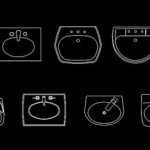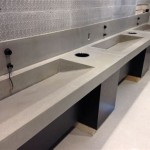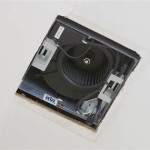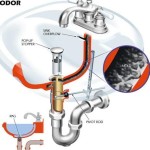Removing an Old Kohler Bathroom Faucet: A Comprehensive Guide
Replacing a bathroom faucet can significantly update the look and functionality of a bathroom sink. While professional plumbing services are available, removing an old Kohler bathroom faucet is a manageable DIY project for homeowners possessing basic plumbing knowledge and the appropriate tools. This article provides a detailed guide on safely and effectively removing an old Kohler bathroom faucet, covering preparation, step-by-step instructions, and potential challenges encountered during the process.
Before initiating the removal process, it is crucial to understand the different types of Kohler bathroom faucets. Kohler offers a variety of faucet styles, including centerset, widespread, single-hole, and wall-mounted faucets. Understanding the faucet type is essential as it influences the method and tools required for removal. Each type possesses unique installation characteristics which dictate the necessary dismantling approach. For instance, widespread faucets involve separate hot and cold water handles and a spout, each independently connected to the sink. Centerset faucets, on the other hand, feature handles attached directly to the spout base, simplifying the removal process to some extent. Familiarity with the existing faucet's configuration will significantly contribute to a smoother and more efficient removal process.
Safety is paramount when working with plumbing. Before commencing any work, turn off the water supply to the faucet. This prevents potential flooding or water damage during the removal process. Locate the shut-off valves under the sink, which are typically small, oval-shaped handles connected to the water supply lines. Turn these valves clockwise until they are completely closed. Once the water is shut off, turn on the old faucet to relieve any remaining pressure in the lines. Placing a bucket or container underneath the faucet and supply lines is recommended to catch any residual water. Wearing safety glasses is advisable to protect the eyes from debris or splashing water.
Gathering the Necessary Tools and Materials
Having the right tools readily available is critical to a successful faucet removal. The following tools and materials are typically required:
*Adjustable Wrench:
An adjustable wrench is essential for loosening and tightening various nuts and bolts associated with the faucet connections. *Basin Wrench (Faucet Wrench):
This specialized wrench is designed to reach into tight spaces underneath the sink, allowing access to the faucet's mounting nuts and connections. *Pliers:
Pliers can be useful for gripping stubborn nuts or connections and for manipulating supply lines. *Screwdrivers (Phillips and Flathead):
Screwdrivers are necessary for removing any screws that secure the faucet or its components. *Penetrating Oil:
Applying penetrating oil to corroded nuts or bolts can help loosen them, making removal easier. *Bucket and Rags:
A bucket and rags are essential for catching water and cleaning up any spills. *Safety Glasses:
Safety glasses protect the eyes from debris and potential splashes. *Work Gloves:
Work gloves provide grip and protect the hands from sharp edges and potential irritants. *Flashlight or Headlamp:
A flashlight or headlamp provides adequate lighting to see clearly in the often dimly lit space under the sink. *Putty Knife or Scraper:
A putty knife or scraper can be used to remove old plumber's putty or sealant from the sink surface.Depending on the age and condition of the faucet, additional tools like a pipe wrench or a hacksaw may be necessary to address particularly stubborn or corroded connections. It is prudent to have a variety of tools on hand to accommodate unforeseen challenges.
Step-by-Step Faucet Removal Process
Once the water supply is shut off, and the necessary tools are assembled, the faucet removal process can begin. The following steps provide a general guideline, but the specific procedure may vary slightly depending on the Kohler faucet model and installation.
1. Disconnecting the Water Supply Lines:
Begin by disconnecting the water supply lines from the faucet's tailpieces. These lines are typically connected using compression fittings or threaded connections. Use two wrenches: one to hold the faucet tailpiece steady and the other to loosen the nut connecting the supply line. Carefully disconnect the lines, ensuring that any remaining water is captured in the bucket. If the supply lines are old or corroded, consider replacing them with new ones during the faucet installation.
2. Loosening the Mounting Nuts:
The faucet is typically secured to the sink using mounting nuts located underneath the sink. These nuts can be difficult to access due to the limited space available. A basin wrench is the ideal tool for this task. Position the basin wrench around the mounting nut and tighten its jaws securely. Turn the wrench counterclockwise to loosen the nut. It may be necessary to apply penetrating oil to the nuts if they are corroded or stuck. Patience and persistence are often required to loosen these nuts, especially on older faucets. Repeat this process for all mounting nuts securing the faucet.
3. Removing the Faucet:
Once the mounting nuts are loosened, carefully detach them from the faucet's mounting studs. With the nuts removed, the faucet should be free to lift away from the sink. Gently wiggle the faucet to break any remaining seal with the sink surface. If the faucet is stuck, use a putty knife or scraper to carefully cut through any old plumber's putty or caulk sealing the faucet to the sink. Lift the faucet straight up and away from the sink to avoid damaging the sink or surrounding countertop.
4. Cleaning the Sink Surface:
After removing the faucet, thoroughly clean the sink surface to remove any remaining plumber’s putty, caulk, or debris. Use a putty knife or scraper to gently remove any residue. Clean the area with a mild cleaner and water to ensure a clean and smooth surface for the new faucet installation. Inspect the sink for any damage or cracks and address them before installing the new faucet.
5. Inspecting and Replacing the Supply Lines (Optional):
With the old faucet removed, this is an opportune time to inspect the water supply lines for any signs of wear, corrosion, or damage. If the supply lines are old or in questionable condition, replacing them is a prudent preventative measure. New supply lines will ensure a leak-free connection and prevent potential plumbing problems in the future. Measure the distance from the shut-off valves to the faucet tailpieces to determine the correct length of the new supply lines.
Addressing Potential Challenges and Troubleshooting
Removing an old Kohler bathroom faucet can sometimes present challenges, especially in older bathrooms. Being prepared for these potential issues can help ensure a smoother and more efficient removal process.
*Corroded or Stuck Nuts:
Corroded or stuck mounting nuts are a common problem. Applying penetrating oil liberally to the nuts and allowing it to soak for several hours or even overnight can help loosen them. Using a longer wrench or cheater bar can provide additional leverage to break the nuts free. If the nuts are severely corroded, using a nut splitter or cutting them off with a hacksaw may be necessary. *Tight Spaces:
The limited space under the sink can make it difficult to access the mounting nuts and connections. A basin wrench is specifically designed to address this issue, but maneuvering it in tight spaces can still be challenging. Using a headlamp or flashlight to improve visibility is crucial. Taking breaks and repositioning yourself can also help alleviate fatigue and improve access. *Damaged or Stripped Screws:
Screws that secure the faucet handles or other components may be damaged or stripped, making them difficult to remove. Using a screw extractor or a specialized screwdriver with a gripping surface can help remove stripped screws. If the screw is severely damaged, drilling it out may be necessary. *Frozen Supply Lines:
Occasionally, the water supply lines may be frozen due to mineral buildup or corrosion. Applying heat to the lines with a heat gun or hair dryer can help thaw them. Be careful not to overheat the lines, as this could damage them or the surrounding materials. Avoid using an open flame to thaw frozen lines. *Water Leaks:
Even after shutting off the water supply, some residual water may remain in the lines. Keep a bucket and rags handy to catch any water that leaks out during the removal process. If a significant amount of water continues to leak, double-check that the shut-off valves are completely closed. If the valves are faulty, they may need to be repaired or replaced.Proper preparation, the right tools, and a methodical approach are key to successfully removing an old Kohler bathroom faucet. While challenges may arise, understanding the potential issues and having appropriate solutions readily available will contribute to a smooth and efficient project. Once the old faucet is removed, the sink is ready for the installation of a new Kohler faucet, enhancing the aesthetic appeal and functionality of the bathroom.

The Pro Way To Replace A Bathroom Faucet Diy 760 594 1226

How To Remove Kohler Bathroom Faucet Cartridge Bargain
Antique Kitchen Sink Faucet Servicing

How To Remove And Install A Bathroom Faucet

Have A Question About Kohler Forte 4 In Centerset 2 Handle Low Arc Water Saving Bathroom Faucet Polished Chrome With Sculpted Lever Handles Pg 1 The Home Depot

Kohler Wide Spread Taboret Lavatory Faucet Stems Replaced

How To Remove A Single Stem Kohler Kitchen Faucets Infinity
Hard Time To Remove Old Kohler Kitchen Faucet Diy Home Improvement Forum

How To Replace A Kohler Shower Faucet Cartridge

Diy Kohler Bathroom Sink Widespread Faucet Installation Diyprojectsbydave
Related Posts







